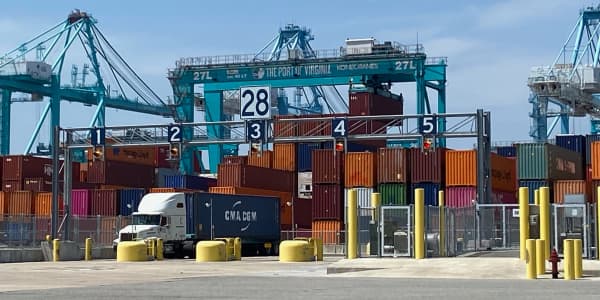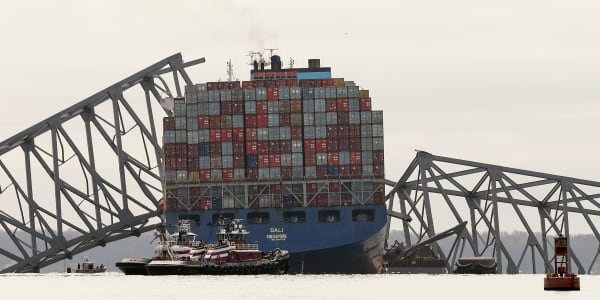Russia's ongoing invasion of Ukraine is causing a global shift in the trading of grains — which feed billions of people every day — and Ukraine's harvest this year could plummet by as much as 50% compared to before the war.
Both Ukraine and Russia were among the world's top producers of commodities such as wheat and barley before the war broke out in February 2022. But the conflict saw the price of U.S. wheat and corn futures hit decade highs (with one benchmark wheat contract hitting an all-time high) and sparked volatility in global wheat prices throughout the year. Prices stabilized in 2023, dropping around 13% in the year to date.
"Trade flows change and fluctuate, they always have," said Andrew Whitelaw, co-founder and director of Episode 3, an agricultural analysis firm. "Bearing in mind that 20-odd years ago, Russia wasn't an important exporter of grains … It's grown in the last 20 years [and] Ukraine and Russia have now become the top exporters."
And while last year's yield and export of grains such as wheat from Ukraine were still significant despite the war and closure of ports in the Black Sea, the quantities harvested and shipped this year are likely to reduce.
The Black Sea Grain Initiative, a deal brokered by the U.N. in Turkey to guide ships safely out of Ukrainian ports, was only extended by 60 days in March — a reduction on the previous 120-day period.
Whitelaw described last year's wheat crop as "pretty good" in Ukraine and "absolutely fantastic" in Russia, but said Ukraine's harvest is likely to be down around 20% in 2023 because farmers have sown fewer crops.
"This year, there's things like — in Ukraine — lack of access to finance, lack of access to fertilizers, fuel, labor, but also the price of grain in Ukraine is really low. So, the incentive for the farmers to plant it is lower," he told CNBC via phone.
"We're seeing lower acreages or area devoted to these crops in Ukraine, which means that probably the larger impact of it may be felt this year, from a supply and demand fundamentals [perspective] than last year."
The Ukraine losses will need to be made up elsewhere over time, including from Russia itself but with a stronger focus on US, Canada, Brazil, and Argentina.Aakash DoshiCiti Research
Indeed, figures from the U.N. Food and Agriculture Organization suggest that 20-30% of the acreage of winter wheat crops sown in Ukraine last year will not be harvested this summer because of a lack of fuel availability.
Aakash Doshi, who is head of commodities, North America at Citi Research, said that Ukrainian grain harvests and exports this year could be down as much as 50% on pre-war levels.
Ukraine had a bumper corn crop of 42 million metric tons (mmt) in 2021, per Citi Research figures, and the bank estimates this will reduce to between 21 and 22 mmt in 2023/24.
For wheat, the 2021 harvest was 33mt, according to Citi Research, and its forecast for this year "might be 16-17mmt," Doshi told CNBC by email.
As well as crop yields, exports will also reduce, he said. "Grain trade flows from Ukraine should see volumes decline, but not as much as outright production declines, since domestic consumption is weak. 2023/24 Ukraine grains exports (corn + wheat) might be 27-30mmt, down 15-18mmt from 2021/22," he added.
There is a current surplus of Ukrainian grain in Central European countries, creating a rift with countries including Poland, Hungary, Bulgaria and Slovakia.
Falling prices caused protests among Polish farmers as well as the resignation of Poland's Agriculture Minister Henryk Kowalczyk this month. On April 7, his successor Robert Telus said exports of grain from Ukraine to Poland would be limited and halted "for now," according to a Reuters report.
Longer term, Doshi sees opportunities for grain exports from North and South America to the Middle East, North Africa and Asia, and if crops are good, from Australia to East Asia.
"In other words, the Ukraine losses will need to be made up elsewhere over time, including from Russia itself but with a stronger focus on U.S., Canada, Brazil, and Argentina exportable surplus," Doshi said.
Agricultural analyst Whitelaw also said the market is likely to shift, including from Russia. "The trade flows will have to change and there's not that many places that you can get large volumes of grain to replace the volumes that Russia has been [providing]. And so, it really is down to … South American countries, the U.S., parts of Europe and Australia," he said.
Global food trade
The war in Ukraine has contributed to rising food prices, with inflation above 5% in more than 80% of low-income countries, according to World Bank figures.
But while restrictions on exports from Ukraine have had an impact on food prices, rising energy and fertilizer costs are likely to have an even greater effect, according to research by a team at Edinburgh University led by Peter Alexander, published in February. The study suggests that there could be up to 1 million additional deaths in the Middle East, sub-Saharan Africa and North Africa if high fertilizer prices prevail this year.
Longer term, the picture is complex. Climate change causing extreme weather is already damaging the food system, according to Alexander, a senior lecturer at Edinburgh University's Global Academy of Agriculture and Food Systems. But how this could develop is unclear, he told CNBC: "The impact of future extreme weather ... drought, heat, flooding, is really not well understood."
A key risk is if grain production halts in a number of places at once, Alexander added, known as "multiple breadbasket failure."
"There's definitely the possibility that we could see that type of event in the future, which could have really negative consequences for lots of people," he added.
Factors affecting the price and availability of commodities and food overall are many and varied — bad weather in Morocco and Spain was blamed for a shortage of fruit and vegetables in the U.K. in February, but additional paperwork due to Brexit was also cited, plus high energy prices.
Ways to prevent food shortages around the world are also not straightforward, with many "competing narratives," according to Alexander. For example, localizing food chains may not help.
"The reason why we have a globalized food system, and the reason why food has become cheaper and cheaper over the last decades, is because ... competitive advantage [means] we produce food where it's the easiest to produce it, where it has the lowest inputs ... If we start bringing everything back more locally, it actually is less efficient as a food system," he said.
"For example, in the U.K., we are self-sufficient in wheat, but we are still subject to the global market for wheat prices," he added.
Also, higher food prices aren't necessarily a bad thing, according to Alexander. "Rather than try to maintain artificially low food prices, or food prices that don't reflect all the costs ... maybe we can make the healthier, more sustainable foods, we can subsidize them for everybody," he suggested.
Reducing meat consumption in developed countries might also be an option. "We need a more equitable and more efficient food system, which does very likely involve dietary change from a Western perspective," Alexander added.
Another debate is over how much grain should be used for biofuels versus food supplies. In biofuel, grain is used to produce ethanol, which is blended with gasoline to cut down emissions.
Reducing the grain used to produce ethanol by 50% in the U.S. and Europe "would compensate for all the lost exports of Ukrainian wheat, corn, barley and rye," according to the research company World Resources Institute in a post published on April 1 2022, about five weeks after Russia invaded Ukraine.
"We still have large amounts of grain around the world that is not used for food ... in our industrial processes, ethanol, biodiesel, those types of products. I expect we'll see more of that debate in the coming couple of years," Whitelaw said.




